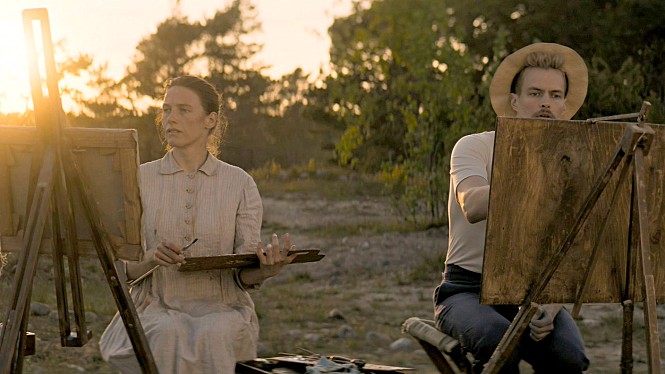Finnish film “Helene” is about the late life and career of Helene Schjerfbeck (1862-1946), who, as far as I can observe from her several notable works shown at the end of the film, deserves to be mentioned along with more renowned Scandinavian painters such as Edvard Munch. While many of her later works look rather simple on the surface, their simplicity is indelible and sublime to say the least, and the movie did a fairly good job of presenting the personality and artistry behind these interesting works.
The movie, which is set during 1915-1923, opens with a brief prologue scene showing how Schjerfbeck (Laura Birn) was often underrated and overlooked at that time. She feels very uncomfortable as being interviewed by some newspaper reporter, and the reporter assures that he will not ask any hard question, but, what do you know, he soon reveals his gender bias on her and her works, which makes her wince silently behind her calm composure.
We subsequently see Schjerfbeck’s daily life with her old mother in their house located in some rural area. As a woman who has always disapproved of her daughter’s artistic activities, Olga (Pirkko Saisio) often grates on her daughter even she does not speak at all, but Schjerfbeck has tolerated her mother anyway, mainly because she knows well that her cranky mother will not be welcomed in her older brother’s house. Although it is hard for everyone due to the World War I, she shows some considerable to her mother nonetheless, and her mother seems to appreciate that to some degree even though she never expresses that at all.
Except the sincere support from her close feminist friend Helena Westermarck (Krista Kosonen), Schjerfbeck’s artistic career still does not look that optimistic, but there comes an unexpected change on one day. Gösta Stenman (Jarkko Lahti), who is a well-known artwork dealer, comes along with a young art critic/amateur painter named Einar Reuter (Johannes Holopainen), and they are all quite impressed by what Schjerfbeck has drawn during last several years. When Stenman offers to buy all of her paintings for exhibiting and selling them in Helsinki, she is understandably skeptical at first, but, to her surprise, he keeps his words, and her paintings do draw attentions from others as being auctioned at high prices shortly after the exhibition.
Meanwhile, Reuter begins to approach closer to Schjerfbeck as admiring more of her works, and she does not mind that at all despite the considerable age gap between her and this handsome lad. When she tries to adjust the light setting on her paintings because it does not feel light to her, he gladly gives her some help, and that leads to more relationship development between them. After she invites him to her residence for sharing her artistic process with him, he suggests that they should have a vacation together on a beach, and everything looks fine and well to her when they enjoy a little private moment together.
As their relationship becomes more serious day by day, Schjerfbeck starts to consider spending the rest of her life with Reuter, but then Reuter becomes more distant to her as he is absent for a while due to his forestry job. He promises that he will correspond with her during that period, but he also says that exchanging only one letter will be enough for them.
What occurs next is not particularly surprising, but it surely hurts Schjerfbeck a lot, and the mood accordingly becomes moodier than before. While her mother is not much of help to her as before, her close friend stands by her as usual, and her art dealer turns out to be more caring than expected when he drops by her house at one point later in the story.
Leisurely gliding us from one small moment to another, the screenplay by director/co-producer/co-writer Antti Jokinen, who adapted the novel of the same name by Rakel Liehu along with Marko Leino, thoughtfully and sensitively depicts its heroine’s emotional journey, which is often accompanied with a number of gorgeous visual moments filled with authentic period atmosphere and details. The cinematography by Rauno Ronak is often stunning in its serene poetic beauty unfolded onto the screen, and I especially admire one mesmerizing outdoor shot, which shows Schjerfbeck and Westermarck from the distance as emphasizing the vast ethereal landscape in front of them. The production design by Jaagup Roomet and the costume design by Eugen Tamberg are impeccable on the whole, and the score by Kirka Sainio is mixed well with a number of various pieces of classical music including J.S. Bach’s “Prelude in B minor BWV 855A” on the soundtrack.
The movie is also supported well by the strong performance by Laura Birn, who is constantly engaging in her nuanced acting. As she diligently carries the film with quiet passion and intensity, the other main cast members including Johannes Holopainen, Krista Kosonen, Pirkko Saisio, and Jarkko Lahti dutifully fill their respective spots as required, and I was sort of amused by Holopainen looking quite serious in contrast to his comic performance in “Heavy Trip” (2018)
On the whole, “Helene”, which was somehow released in South Korean theaters in last month, will surely require some patience from you due to its slow narrative pacing and dry storytelling approach. I must confess that I felt impatient at times during my viewing, but the movie is ultimately rewarding as providing intimate glimpses into the artistic maturation and advance of one very talented female artist to observe, and I recommend you to give it a chance someday.










